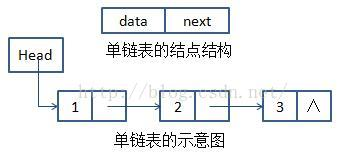以下暂时只写明一些基本操作,待续。
一、简介
链表是动态分配存储空间的链式存储结构。
链表包括一个“头指针”变量,其中第0个结点称为整个链表的头结点,头结点中存放一个地址,该地址指向一个元素,头结点一般不存放具体数据,只是存放第一个结点的地址。链表中每一个元素称为“结点”,每个结点都由两部分组成:存放数据元素的数据域和存储直接后继存储位置的指针域。指针域中存储的即是链表的下一个结点存储位置,是一个指针。多个结点链接成一个链表。最后一个结点的指针域设置为空(NULL),作为链表的结束标志,表示它没有后继结点。
示意图:

二、链表的结构体

typedef int DataType; typedef struct Node { DataType data; struct Node *next; }Node, *PNode;
三、链表的创建

///创建节点 PNode createNode(DataType value) { PNode node = (PNode)malloc(sizeof(Node)); node->data = value; node->next = NULL; return node; } ///创建单链表 PNode createList() { int len, value; PNode pHead = (PNode)malloc(sizeof(Node)); ///头节点 pHead->next = NULL; PNode pTail = pHead; ///移动的节点 puts("请输入单链表的节点数:"); scanf("%d", &len); for (int i = 0; i < len; ++i) { scanf("%d", &value); PNode pNode = createNode(value); pTail->next = pNode; pTail = pNode; } return pHead; }
四、链表的长度

///获取链表长度 int getListLength(PNode pHead) { int len = 0; while (pHead->next != NULL) ///实际上计算的是头节点开始到倒数第二个节点的个数,但仍是节点的个数 { pHead = pHead->next; len++; } return len; }
五、链表是否为空

///判断链表是否为空 bool isEmpty(PNode pHead) { if (pHead->next == NULL) return false; else return true; }
六、链表的节点插入

///单链表插入节点 bool insertNode(PNode pHead, DataType value, int pos) { PNode pPos = pHead; if (pos < 1 || getListLength(pPos) < pos) return false; for (int i = 0; i < pos - 1; ++i) ///所需要的是pos-1的指针 { pPos = pPos->next; } PNode pNode = createNode(value); pNode->next = pPos->next; ///插入节点时,只需修改要插入的节点的next和插入位置的上一个节点的next pPos->next = pNode; return true; }
七、链表的节点删除

///单链表删除节点 bool deleteNode(PNode pHead, int pos) { PNode pPos = pHead; if (pos < 1 || getListLength(pPos) < pos) return false; for (int i = 0; i < pos - 1; ++i) { pPos = pPos->next; } if (pos == getListLength(pHead)) ///如果pos刚好是单节点链表的节点位置,则直接释放该节点,并将头节点next为null { free(pPos->next); pPos->next = NULL; return true; } PNode p = pPos->next->next; ///先拷贝要释放的指针,以便后面使用 free(pPos->next); ///释放指针内存 pPos->next = p; ///使用前面拷贝的指针 return true; }
八、整合

#include<stdio.h> #include<malloc.h> typedef int DataType; typedef struct Node { DataType data; struct Node *next; }Node, *PNode; ///创建节点 PNode createNode(DataType value) { PNode node = (PNode)malloc(sizeof(Node)); node->data = value; node->next = NULL; return node; } ///创建单链表 PNode createList() { int len, value; PNode pHead = (PNode)malloc(sizeof(Node)); ///头节点 pHead->next = NULL; PNode pTail = pHead; ///移动的节点 puts("请输入单链表的节点数:"); scanf("%d", &len); for (int i = 0; i < len; ++i) { scanf("%d", &value); PNode pNode = createNode(value); pTail->next = pNode; pTail = pNode; } return pHead; } ///遍历单链表 void traverseList(PNode pHead) { puts("单链表的遍历:"); PNode pTail = pHead; while (pTail->next != NULL) ///遍历节点的时候,每次遍历的结束返回的节点都是下一个节点 { printf("%d ", pTail->next->data); pTail = pTail->next; } puts(); } ///判断链表是否为空 bool isEmpty(PNode pHead) { if (pHead->next == NULL) return false; else return true; } ///获取链表长度 int getListLength(PNode pHead) { int len = 0; while (pHead->next != NULL) ///实际上计算的是头节点开始到倒数第二个节点的个数,但仍是节点的个数 { pHead = pHead->next; len++; } return len; } ///单链表插入节点 bool insertNode(PNode pHead, DataType value, int pos) { PNode pPos = pHead; if (pos < 1 || getListLength(pPos) < pos) return false; for (int i = 0; i < pos - 1; ++i) ///所需要的是pos-1的指针 { pPos = pPos->next; } PNode pNode = createNode(value); pNode->next = pPos->next; ///插入节点时,只需修改要插入的节点的next和插入位置的上一个节点的next pPos->next = pNode; return true; } ///单链表删除节点 bool deleteNode(PNode pHead, int pos) { PNode pPos = pHead; if (pos < 1 || getListLength(pPos) < pos) return false; for (int i = 0; i < pos - 1; ++i) { pPos = pPos->next; } if (pos == getListLength(pHead)) ///如果pos刚好是单节点链表的节点位置,则直接释放该节点,并将头节点next为null { free(pPos->next); pPos->next = NULL; return true; } PNode p = pPos->next->next; ///先拷贝要释放的指针,以便后面使用 free(pPos->next); ///释放指针内存 pPos->next = p; ///使用前面拷贝的指针 return true; } int main() { PNode linkedList = createList(); traverseList(linkedList); if (insertNode(linkedList, -2, 3)) { puts("插入成功"); } else { puts("插入失败"); } traverseList(linkedList); if (deleteNode(linkedList, 3)) { puts("删除成功"); } else { puts("删除失败"); } traverseList(linkedList); }
